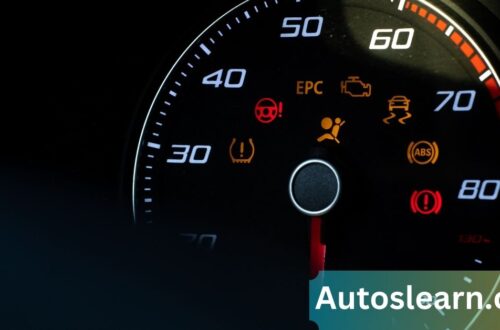If you see a message like “Please reduce oil level” in your Audi Q7, it’s essential to understand what it means, what might have caused it, and how to fix it safely.
Too much oil in the engine can cause real damage if left alone, but it doesn’t always mean something serious. In many cases, it’s fixable at home with a bit of care—or at least a proper check.
Let’s examine what’s going on, what to check first, and how to reduce the oil level correctly.
Why Does the “Reduce Oil Level” Message Appear?
This warning usually shows up when the engine detects an oil level that is too high. It’s often triggered by:
- Recent oil change with too much oil added.
- Parked on a steep incline or uneven ground
- A glitch in the oil level sensor
- Oil mixed with another fluid (like unburned fuel during regeneration)
Not all these cases mean there’s too much oil. But it’s essential to find out.
How the Audi Q7 Monitors Oil Levels:
Most current Audi Q7s lack a genuine dipstick. Instead, they use an electronic oil level sensor, which reads the level and sends a message to your MMI system or dashboard.
The reading only works when:
- The car is warm
- It’s on flat ground
- The engine is turned off for some time.
Checking in the wrong condition can cause a false warning. That’s why the first step is always to recheck the level in proper conditions.
Also Read: How Long Does Audi Service Take-Complete Guide
Signs You Might Have Too Much Oil:

Besides the warning on the screen, here are a few signs that suggest overfilling:
- The smell of oil burning
- Blue or grey exhaust smoke
- Rough idle
- Engine misfire or hesitation
- Oil spots under the car (if pressure pushes oil out)
These are less common but worth watching for. Sometimes, the message can appear without symptoms, often because of the parking angle or temperature.
What to Check Before You Touch the Engine:
Before draining any oil, do a few quick checks:
- Park the car on flat ground. Avoid slopes.
- Allow the engine to cool for about 5 to 10 minutes after turning it off.
- Consider the current oil level with the MMI system or Audi app.
- Open the hood briefly, then close it. This can sometimes reset the sensor.
- Restart the engine. See if the message goes away after a short rest.
If the message returns or doesn’t clear, it’s time to lower the oil safely.
Two Safe Ways to Lower the Oil Level:
Method 1: Drain Oil via the Drain Plug:
What you need:
- Oil catch pan
- Socket wrench
- Safety gloves
- Jack and stands (or ramps)
- New washer for drain plug (optional)
Steps:
- Let the engine cool down.
- Raise the vehicle safely.
- To collect pipe oil, place a drum below the oil pipe stopper.
- Carefully remove the plug and allow a tiny amount of oil to drain (about 200-300ml).
- Re-tighten the plug.
- After a few minutes of driving, lower the vehicle and recheck the oil level.
- Start small. It’s easier to take more out later than to fix a low oil level.
Method 2: Use an Oil Extractor Pump (No need to get under the car):
What you need:
- Manual or vacuum oil extractor
- Long hose attachment
Steps:
- Place the hose in the oil fill opening or dipstick tube (if applicable).
- Pump out about 200–300ml of oil.
- Recheck the level using the MMI system.
- Repeat if needed.
This method is cleaner and works well for minor corrections.
Common Causes of Overfilling in Audi Q7:
From real owner reports, these are some causes you might not expect:
Oil change shops are adding too much. Sometimes, they use general fill charts and not exact engine specs.
- Diesel regeneration cycles: Unburned fuel can end up in the oil, raising the level over time.
- Sensor error: A temporary glitch from steep parking or idling for long periods.
- Incorrect topping-up: Adding oil too soon after shutdown can give a false low reading.
Also Read: Audi A5 Oil Type-Choose the Right
What Happens If You Ignore the Message?

Driving with too much oil can be harmful. Here’s why:
1. Engine Damage Risks:
- High oil levels can cause foaming, which reduces lubrication.
- The pressure allows oil to pass through seals and damage gaskets.
2. Emission Problems:
- Excess oil can enter the exhaust system.
- It might damage the catalytic converter or DPF in diesel engines.
3. Performance Issues:
- The engine may run rough or hesitate under load.
- Long-term overfilling can wear internal parts faster.
It’s not always urgent, but it shouldn’t be ignored for too long.
How to Prevent This Problem Next Time:
- Ask the dealer to fill slightly below max (some owners request 0.5L less).
- Always park your car before checking the oil level.
- Make sure the engine has thoroughly cooled down before adding any oil.
- Keep notes about how much was added after each oil change.
If your model has a known issue with sensor sensitivity, it’s a good idea to keep a manual dipstick tool. Audi dealerships can provide one or check the level with calibrated tools.
Daily Life Examples:

You might wonder how a car has too much oil if you didn’t add any. It can feel strange, but little things in everyday driving and maintenance can lead to this problem.
1. After a Routine Oil Change:
Let’s say you took your Audi Q7 to a quick lube shop. The technician fills oil using a general estimate—maybe based on another SUV—but your engine needs a little less. Even 200–300ml extra can trigger the warning. It might not show up right away, but later, during a drive, the sensor reads “too full.”
This is common. It happens quietly and without error from your side.
2. Parking on a Slope:
You drive up a sharp driveway and park nose-up. Suddenly, the screen says, “Please reduce the oil level.” No one added oil. However, the incline caused oil to flow into one side of the pan, confusing the sensor.
The warning may clear once the car is back on flat ground and restarted.
3. Cold Weather Driving:
A driver in a cold region parks their Q7 outside overnight. The following day, the oil is thicker and hasn’t settled fully. They take a quick look at the MMI oil level and notice it is low. They top up with half a quart.
Later that day, the car warmed up, the oil spread evenly, and now it reads too full. It wasn’t a lousy sensor—just poor timing.
4. Short Drives with a Diesel Engine:
Some diesel Audi Q7s run regeneration cycles to clean their filters. If these aren’t completed, extra fuel may stay unburned. That fuel occasionally mixes with engine oil, and the oil level slowly rises.
Over weeks or months, it crosses the limit. The car shows a warning even though no oil was added. It’s not a system failure, just a side effect of too many short trips.
5. Checking Too Soon After Engine Shutdown:
Someone turns off their Audi and quickly checks the oil using the app or MMI. It shows below max. They add a little, but the oil hasn’t drained down yet. Once settled, the car reports that it has too much oil.
Timing matters. Even a slight delay before checking can make the reading more accurate.
These examples aren’t rare. They’re based on fundamental Q7 drivers sharing what they’ve seen. Understanding how daily behaviors affect your oil level can help avoid future alerts.
Also Read: Which Audi Drive Select Is Best For Gas Mileage-A Complete Guide
Frequently Asked Questions:
Q1. How do you reduce engine oil levels in an Audi Q7?
If the warning says too much oil, turn off the engine when safe. Let it cool for a few minutes. There are two common ways to remove extra oil:
- Using a suction pump: Insert it through the oil fill cap or dipstick tube and draw out small amounts.
- Loosening the drain plug: This strategy removes only a tiny amount at a time to avoid draining too much.
Do this slowly and check the oil level on your MMI each time until the warning disappears or it shows a safe level.
Q2. What are the effects of putting too much oil in your Audi?
Overfilling can cause the crankcase ventilation system (PCV) to carry oil where it shouldn’t go. This might include the intake system or catalytic converter. It can lead to:
- Oil leaks from pressure buildup
- Damage to sensors and emissions parts
- Rough running or blocked airflow pipes
- In rare cases, the engine might not start if oil fills the cylinders.
Even a tiny overfill can cause long-term wear, so it’s worth addressing soon.
Q3. How do you reset the oil level sensor on the Audi Q7?
There is no manual reset option for oil level sensors in most Audi Q7 models. The reading resets automatically after the following:
- Parking on level ground
- Waiting a few minutes after the shutdown
- Starting the car again at operating temperature
If the message stays, it could be due to a faulty sensor or actual overfill. Some workshops use a diagnostic tool (OBD scanner) to verify sensor data.
Q4. How do I reduce oil consumption in my Audi?
Excessive oil usage in some Audi engines is a known issue. Here are a few ways drivers have reduced it:
- Software update: At times, Audi updates the ECU software to help reduce issues related to oil consumption. This is done at a dealer.
- Crankcase fix: Replacing old crankcase ventilation parts can reduce oil flow into the intake system.
- Mechanical repair: Replacing piston rings or rods may help in older or high-mileage engines. This requires inspection and is usually not a DIY task.
- Drive habits: Short trips where the engine doesn’t reach full temp can increase oil use. Longer drives at normal speeds help the engine burn fuel cleanly.
If you notice drops between oil changes, ask a technician to run a consumption test.
Conclusion:
A “reduce oil level” message in your Audi Q7 might seem worrying, but it often has a simple cause. Sometimes, too much oil is added after service. Other times, it’s a sensitive sensor triggered by slope, temperature, or regen cycles.
Before doing anything, confirm the reading under the right conditions. If it’s genuinely overfilled, remove the oil carefully using the steps above. If the message keeps returning or the oil looks unusual, it’s worth asking a trusted mechanic or Audi tech to inspect further.
Keeping oil at the right level is key to engine health. A little care now helps avoid more significant issues later.




